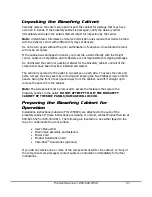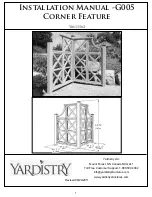
Product Service 1-800-522-7658
42
ECM Motor
The modern Class II Biosafety Cabinet was developed in the early 1960’s as a
result of the increased availability of High Efficiency Particulate Air (HEPA) filter
technology. The motor of choice at the time to drive the cabinet’s blower was
the Permanent Split Capacitor (PSC) type. At the time, the PSC motor offered
manufacturers an inexpensive power source whose speed could be electronically
controlled to allow for airflow adjustment as the HEPA filter(s) loaded.
The PSC motor is known as an induction type, for stationary windings (stator)
surround a rotating part (rotor) composed of iron or steel. As current passes
through the stator windings, it induces a magnetic field in the rotor, causing it to
rotate towards the shifting field in the stator. Because a magnetic field must be
induced in the rotor, the PSC motor is asynchronous, with the rotor constantly
lagging behind the fields being created in the stator. As a result of this
asynchronous operation, the PSC motor is inefficient, and generates high
amounts of waste heat. Attempting to control the blower speed by reducing its
voltage only increases the inefficiency of the PSC motor.
DC motors are more efficient than their AC counterparts. In a typical DC motor,
the stator in an AC motor is replaced with permanent magnets. The rotor then
has a series of windings around it. When current is applied to the motor, a
magnetic field is created in some of the windings of the rotor, causing it to rotate
toward the magnetic field created by the permanent magnets. Brushes in contact
with a commutator allow the current, and thus the magnetic field in the rotor to
progressively shift from winding to winding, forcing the rotor to keep rotating.
The greatest drawback of brushed DC motors is the brushes-they wear
themselves and the commutator down, eventually causing motor failure.
With the development of greater microprocessor power in the 1970s and 80s,
the stage was set for an even more efficient type of DC motor – the
Electronically Commutated Motor (ECM).
Figure 1-10
In the ECM, the magnets and windings switch position –
the permanent magnet is on the rotor, and the series of
windings are placed around the rotor. The
microprocessor precisely controls the creation of
magnetic fields in the stator, so that the rotor is always
synchronous with the magnetic fields being created in
the stator. As a result, the ECM will always run more
efficiently and cooler than a comparable PSC motor.
Because of the simple, robust construction of the ECM, it
offers far greater reliability and operational service life
than the PSC motor.
Controlling the motor’s operation with a microprocessor adds numerous
advantages. Motor speed can be efficiently controlled across a speed range that
would damage or destroy a PSC motor. Given enough microprocessor memory
and power, the manufacturer can program in any number of user-selected
programs controlling motor speed, power and even direction of rotation. The
ultimate expression of the power of the ECM was the development of the
















































